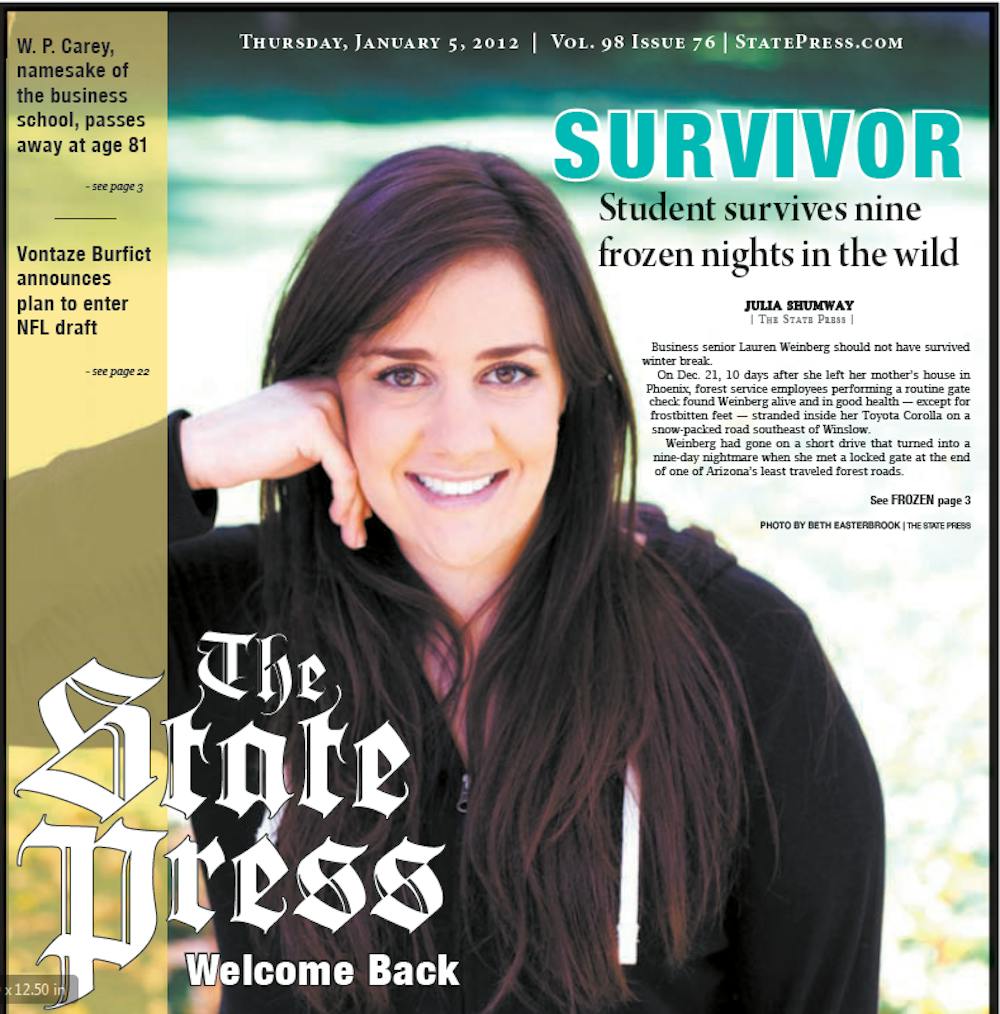Business senior Lauren Weinberg should not have survived winter break.
On Dec. 21, 10 days after she left her mother's house in Phoenix, forest service employees performing a routine gate check found Weinberg alive and in good health — except for frostbitten feet — stranded inside her Toyota Corolla on a snow-packed road southeast of Winslow.
Weinberg had gone on a short drive that turned into a nine-day nightmare when she met a locked gate at the end of one of Arizona’s least traveled forest roads.
“After about 30 minutes of being stuck there, two guys actually pulled up and said they were going to go back to their house and get something to help me get unstuck,” she said. “I was kind of banking on that.”
However, the two men did not return.
Weinberg, a Phoenix native, said she was unprepared for the length of time she spent in the snow.
Other than basic skills she learned in Brownies and Girl Scouts, she had nothing but common sense to help her through the long days.
She said many media sources told parts of her story incorrectly, including how much food she had and what she did while she was stuck.
Weinberg had only a Snickers bar, which she ate on the second day, and a few clear plastic water bottles that she refilled with snow during her stay.
“I came up with a pretty good system for water and keeping warm,” Weinberg said.
For warmth, she wrapped herself in the car’s rubber floor mats when she slept in the back seat.
She also used the mats to keep her legs dry when, on her third night, she tried to hike through knee-high snow and find help. But snow still seeped through her Uggs, she said.
That night, Weinberg slept outside on a rock, which she said was one of the scariest experiences of the nine days.
“When I woke up there was ice on my back,” Weinberg said. “There were coyotes howling from side to side of the mountains and I thought that I was going to get eaten alive.”
Weinberg said her phone broke from the cold.
“Being out there with no book, no phone, no anything, all I had to do was to talk to myself and God and I really feel like I found God and that’s how I survived,” Weinberg said.
She stressed the power positive thinking had to help her endure this predicament. She said she ended up defiantly singing “I’m a Survivor” and “I Will Survive” at the mountain peaks around her.
While few survive after being stranded as long as Weinberg, getting stuck in the snow is common, Coconino County Sheriff's Department spokesperson Gerry Blair said.
The search and rescue unit, made up of a few paid personnel and about 80 volunteers, receive as many as four calls per week from people stuck in their cars and hikers or hunters.
“What is uncommon is that she survived for (nine) days in some pretty extreme weather,” Blair said.
Blair said most are found within 24 hours of being reported missing.
However, Weinberg’s parents did not call police until several days after she did not return and no one knew where she was headed.
This left the sheriff's department with no place to start an air or ground search and was her biggest mistake, said Professor Scott Kozakiewicz, who has taught an outdoor survival class at ASU for the last 21 years.
"You've got to tell (somebody) where you're going and when you're going to return and what to do if you don't return," Kozakiewicz said.
After making the destination of a trip known, people should be sure to be prepared by bringing enough blankets, food, water and any other supplies necessary to support everyone in the vehicle when they leave the Valley, he said.
Kozakiewicz also stressed staying with the vehicle and use its parts for survival, like Weinberg’s use of her rubber floor mats.
The bottom line, Kozakiewicz said, is to be careful and prepared whenever one leaves the Valley.
"(Going out on snowy roads) is just a mistake,” Kozakiewicz said. “It's a mistake that will kill people.”
Reach the reporter at julia.shumway@asu.edu or follow @JMShumway on Twitter.
Like The State Press on Facebook and follow @statepress on Twitter.




